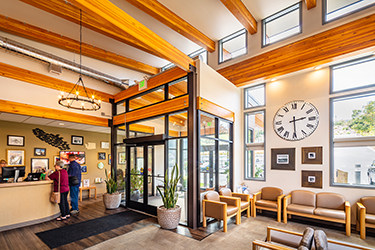|
Subscribe / Renew |
|
|
Contact Us |
|
| ► Subscribe to our Free Weekly Newsletter | |
| home | Welcome, sign in or click here to subscribe. | login |
Construction
| |
 |
July 29, 2021
The shifting need for design in health care services
DLR Group | Salus

Frum
|
As the COVID-19 pandemic diminishes, architects, more than ever before, are working with building owners and operators tasked with creating healthy, equitable spaces for delivery of health care services.
Meanwhile, society is coming to terms with the reality that the frequency of pandemics may increase. According to the World Economy Forum, new pandemics will continue to spread due to increased populations, mobilization, and an easily accessible global society.
The current measures and demand to limit the spread of viruses are here to stay. And organizations are accommodating that demand by shifting the way they allocate space, services and resources. The following key factors are impacting the way we design for health care delivery.
EQUITABLE SERVICES
The health care industry must balance personalized in-person care with virtual care options. In-person meetings develop trust between the provider and the client/patient needed for successful diagnosis and treatments. Hospitals and health care providers are continually seeking the best ways to serve their communities to deliver equitable services to all.
The pandemic has accelerated that need to quickly access services with the least amount of risk. This has resulted in shifting certain spaces and services beyond the hospital walls and out into outpatient facilities, clinics, ambulatory surgical centers and rehabilitation facilities. Not only do these outpatient services reduce costs, compared to the high cost of hospital services, but this allows health care agencies to allocate space into a variety of neighborhoods reaching more individuals. Careful and intentional long-term planning and programming with an architect will help avoid quick-fix solutions that end up costing a health care provider more than if they had invested in a long-term plan with built-in flexibility.
RIGHT-SIZING
While telehealth has been around for several years, 2020 made it a practice that will stay and help in reducing medical costs for many. Telehealth, combined with the trend to decentralize services, is allowing designers to work with health care agencies to realign services, reducing space requirements. For instance, with many patients being seen using virtual meetings, we are able to reduce the typical number of exam rooms in clinics. This reduction in size of the larger clinics allows for more neighborhood centers to open throughout a community. In the current dense urban and suburban areas, it is easier to obtain smaller spaces where such centers can be located, such as the Tacoma Women’s Imaging Center.
When equipment needs to be replaced, increased imaging room size also requires additional increases to adjacent support service rooms for power, data, HVAC, medical gases, etc. And the need for staff participation in designing these rooms for highest efficiencies increases as the room now serves multiple purposes.
SHIFTING METHODS
While some telemedicine can be conducted from a provider’s residence, small conveniently located telehealth centers are supporting health care providers with better technology, acoustical separation, and necessary support and administrative services. These centers can be located independent of the clinic/hospital or attached to them. More complex diagnostic and treatment spaces need to remain in the hospital for efficiency of operation. Less intensive diagnostics can be located within the neighborhood centers for imaging, labs, infusion, etc. And finally, with the advancement of wearable and personal health technologies that can monitor vital signs and physical activity, greater portions of health care are moving toward less physical contact.
Changes in delivering and accessing health care will continue to impact the industry. And planners and designers will continue to meet the shifting need with more efficient spaces for equitable services delivered through the built environment.
Principal R. David Frum is a health care leader with DLR Group | Salus in Seattle.
Other Stories:
- Aggregation will drive a new hybrid science space
- Alternative delivery benefits health care in Washington
- Next-gen health care: Building healthier communities, economies
- Micro hospitals offer the right prescription
- The shape-shifting needs of the health care industry
- Best practices in health care development and delivery
- How flexible design served OHSU during the pandemic
- Evidence-based design improves dialysis treatment experience
- Compounding pharmacies provide community resource



